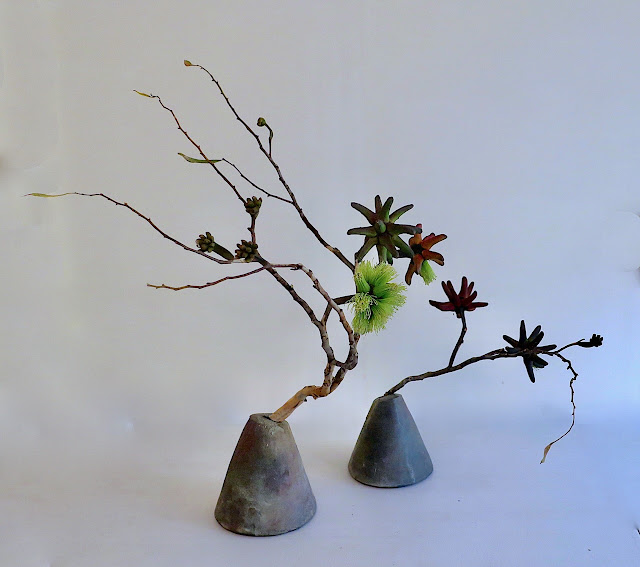Lyn's ikebana featured a branch of London Plane Tree Platanus x acerifolia. Although not quite bare, this branch certainly had a late autumn look. On the right side of the vase are some stems of Cotoneaster with red berries attached.
Louise used bare branches from a Nectarine tree Prunus persica. The branches on the left are unidentified. At the mouth of the vase is a small spray of Sweet Pittosporum Pittosporum undulatum leaves and berries.
Róża used a bare branch of Coast tea tree Leptospermum laevigatum which she positioned to emphasise its sweeping lines. The small contrasting fresh material was Pincushion Hakea H. laurina.
Pamela's materials were not specifically identified. The bare branch was positioned to exploit the counter movement of its lines. The small focus of fresh materials includes a red flowering Eucalyptus
The starkness of Norma's bare branches was highlighted by the small mass of orange-red Manchurian pear Pyrus ussuriensis, which has the function of visually holding the branch lines together and connecting them to the vase.
In the Melbourne class the students' task was to make an ikebana using one material only.
Aileen's material was Bushy Yate Eucalyptus lehmannii. Having first removed all of the leaves, she set the material in two unusual ceramic vessels. The branches have irregular curving lines and feature two stages of the flowers buds and one fully opened flower.
In the garden, the red flowers of the Swan River Pea Gastrolobium celsianum caught my eye in the morning a couple of days ago. The plant is growing beside the garden steps and the early sun was dramatically back-lighting the flowers. It is such a joy to have these flowers open in the middle of winter.
...has recently produced its leaves for the new season. This is one of my favourite large-leafed plants and I am delighted to have it in our garden. It has a particularly beautiful form and I am not surprised that in ancient Greece it was used for the design of Corinthian column capitals. I have been monitoring its growth and decided that I would use this leaf material for my ikebana.










No comments:
Post a Comment